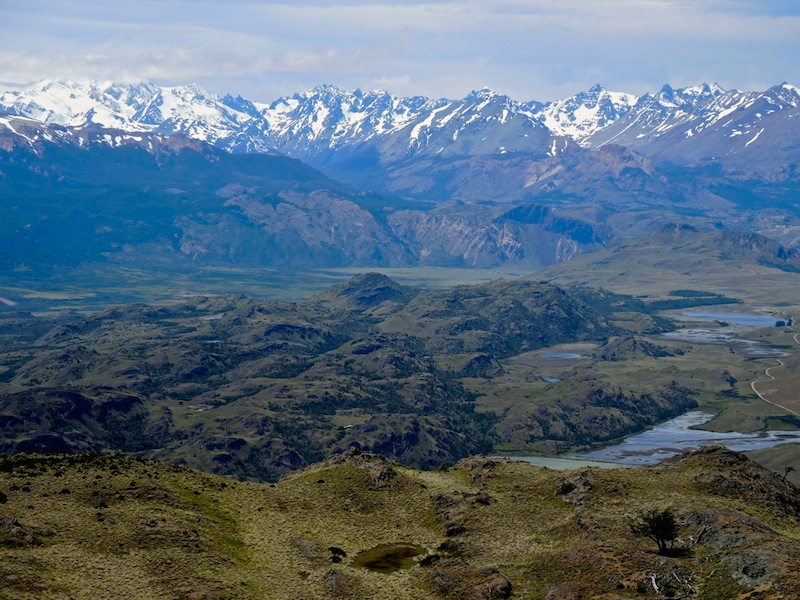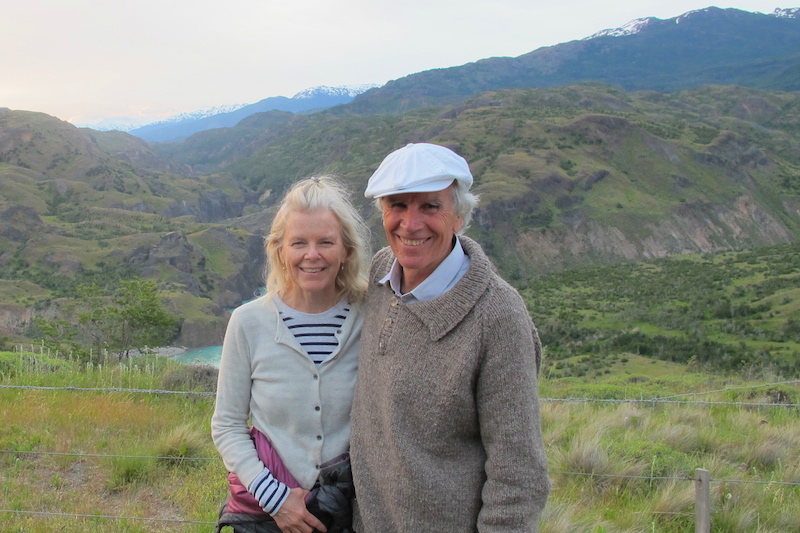Above: Kris & Doug Tompkins. Photo by Dave Henson, Dec. 2014.
The staff and extended family of the Occidental Arts & Ecology Center would like to honor our friend, mentor and OAEC supporter Douglas Rainsford Tompkins. Doug tragically passed away in a kayaking accident in southern Chile yesterday, December 8, 2015.
Legacy
Doug is primarily known as founder of the climbing equipment company The North Face, co-founder of the clothing company Esprit, and dedicated wildlands philanthropist. In addition to honoring this impressive legacy, we at OAEC have had the privilege of working with Doug on some of his many other initiatives. Doug was an early supporter of OAEC (1999-2002) through his Foundation for Deep Ecology and visited the center a number of times, most recently in June 2014. He was the convening funder of what became Wild Farm Alliance – on whose board still sits OAEC Executive Director Dave Henson. In the early 90’s, Doug convened a series of meetings that later became the International Forum on Globalization, which continues to be a leading voice for the critique and rethinking of global corporate hegemony.
Personal Visit
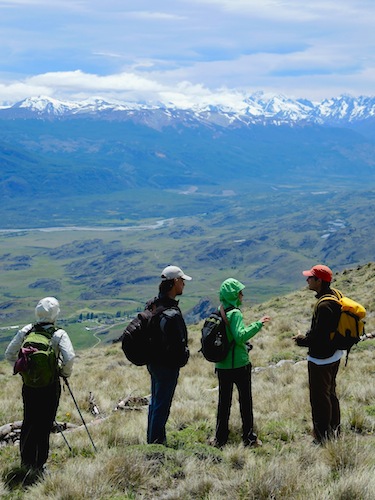
OAEC’s friend and supporter Nancy Schaub has made a number of trips to Chile and Argentina to visit and collaborate with Doug and his wife, Kristine McDivitt Tompkins (Kris), both long-time friends of hers. Seeing the deep alignment between OAEC and Doug and Kris’s many initiatives, Nancy invited OAEC staff Dave Henson and Brock Dolman to join her on a two-week journey to visit them in the Patagonia region of Chile in November 2014. Nancy’s vision was to facilitate a relaxed gathering for deeper discussions between Doug & Kris and OAEC staff concerning environmental and social movement strategies we all share to address the broader state of the world. We also went to see and learn from the extraordinary wildlands and agriculture lands conservation the Tompkins have led for over 20 years in Patagonia, especially Doug’s keen design aesthetics that inspire the ongoing visioning of OAEC’s redevelopment projects. Accompanying us on the November 2014 trip were mutual friends Kristin Rothballer and Bess Bendet.
Our “trip of a lifetime” included being hosted in two of the Tompkins’s homes within National Parks they created. We began at their farm in Reñihué, nestled in verdant fjords of Pumalin Park, and continued onto Valle Chacabuco, a part of Parque Nacional Patagonia. Doug and Kris’s hospitality is legendary. Our accommodations, the food, our conversation and sheer magnitude of their vision were as breathtaking as the vast lands they’ve conserved. The presence of elusive puma, newborn guanacos, regal black-necked swans, and lichen-laden old growth southern beech forests all deepened feelings of gratitude along trails we traversed including the newly created Lagunas Altas and Aviles Valley.
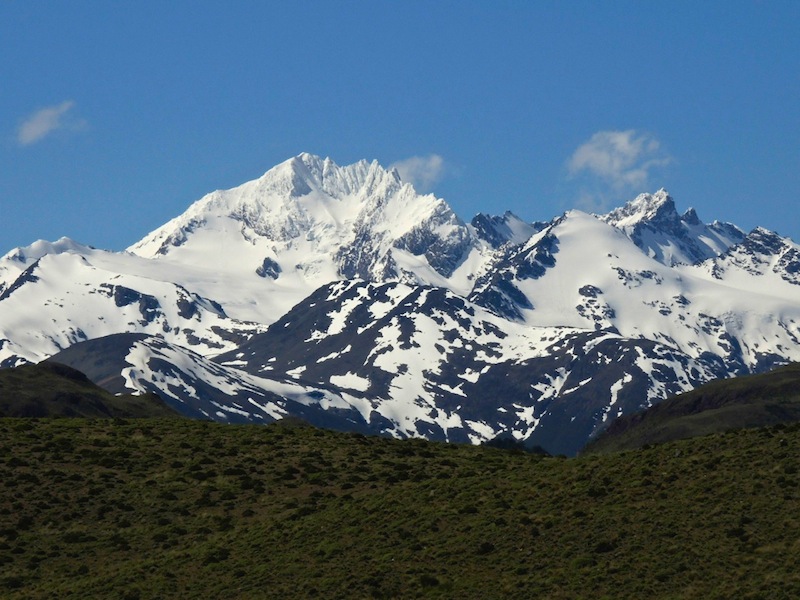
Unrelenting Pursuit of Quality
All who knew Doug marveled at his unrelenting pursuit of quality. Over the decades, Doug’s passion for excellence manifested in a myriad of ways, including lesser-known initiatives such as being a significant collector of Amish quilts from Lancaster County, Pennsylvania that were publicly shown in 1990 by the San Francisco Museum of Modern Art’s exhibition: Amish: The Art of the Quilt, as well as compiling and publishing 60 years of writings by Norwegian philosopher Arne Naess, originator of the Deep Ecology movement.
His fierce passion for a Deep Ecology spanned into political realms, where he negotiated with presidents and government officials to create massive trans-border conservation for future National Parks. Currently these comprise over 2.4 millions acres of land that Doug and Kris have personally secured, are restoring and will ultimately gift to the people of Chile, Argentina and the world. In all of his initiatives, he hand-selected the highest caliber people to shoulder the hard work to realize his vision. In his endless adventurous forays, Doug strove for perfection, seeking out the cleanest line of a summit ascent, a river’s run, or a building’s design.
Bandwidth and Vision
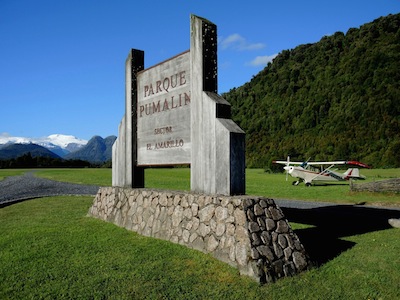
As a designer of clothes, books, farms, buildings, organizations and the future, Doug’s attention to detail was astounding. He was notoriously engaged at every level with all of his projects – from the specifics of the hand-carved wooden bas-reliefs at the entry desk of Pumalin Park to the reintroduction strategies for endangered Jaguar, Giant Anteaters and Andean Rhea. Doug’s bandwidth was immense. His pendulum swung from fighting national battles against damming wild rivers all the way over to multi-million acre conservation schemes. Extraordinarily, simultaneous to his unparalleled capacity for large-scale vision was his undivided attention to detail. We took in his unsurpassed capacity for excellence when admiring the handmade shell buttons on the elegantly crafted local wool sweaters of his “Puma Verde” brand and when touring the facility that produces and packages everything needed for his line of local honey called Pillán Organics.
One of the biggest gifts of being there with Nancy was the privilege of flying with Doug, a longtime pilot, in his beloved two-seater Husky bush-plane. Each one of us had the opportunity to listen to Doug’s inflight narration of his latest land acquisition along with his disdain for industrial salmon farms, all the while catching fly-by close ups of the still smoldering Chaitén volcano. We glided over thousands of acres of protected lush fjords draped in old growth Alerce forests, now protected as a National Park for the people of Chile in lieu of previously being clear-cut by multi-national corporations. After approaching the grassy landing strip over one of Doug’s immaculately designed organic farms (Reñihué, Pillán, Vodudahue and Hornopirén), those of us who flew with Doug spilled out a myriad of adjectives in an attempt to convey the grandeur and exhilaration.
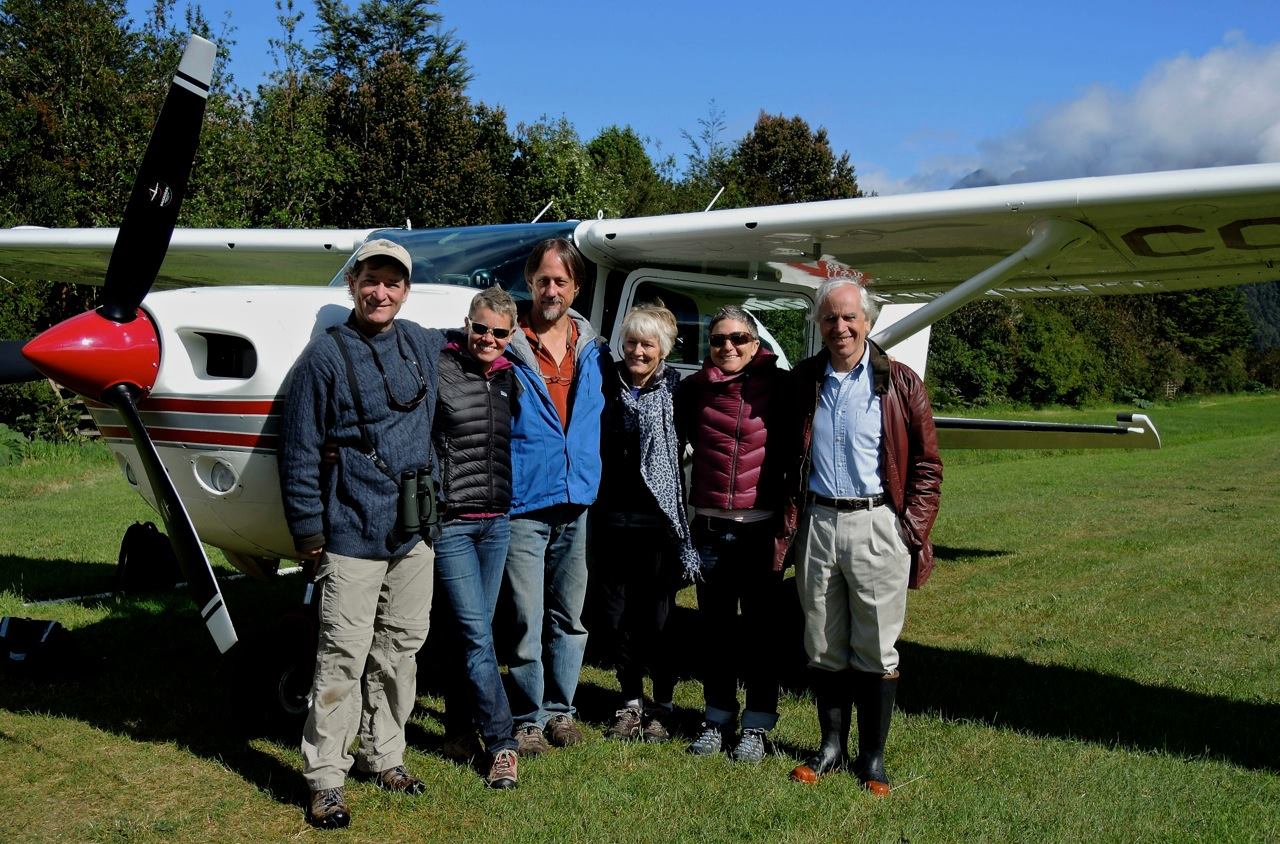
Published Works
Doug’s ire for political and corporate desecration of the planet was balanced with his unbridled love for the truly wild parts of the world as expressed through his numerous large format, impeccably produced books. The OAEC library contains a dozen of his pull-no-punch books that critique industrial civilization, including: Clearcut; Fatal Harvest; Plundering Appalachia; Welfare Ranching; Thrillcraft; CAFO; Wildfire; and Energy. The penultimate book, Over-Development Over-Population Overshoot was released in early 2015 along with the affiliated campaign Global Population Speakout. Doug also illustrated his fierce love of protecting wild nature through the Parklands Book Series, which showcases some of the massive landscapes Doug and Kris have turned into National Parks, such as Yendegaia, Perito Moreno, Corcovado, Monte Leon and the Ibera Wetlands.
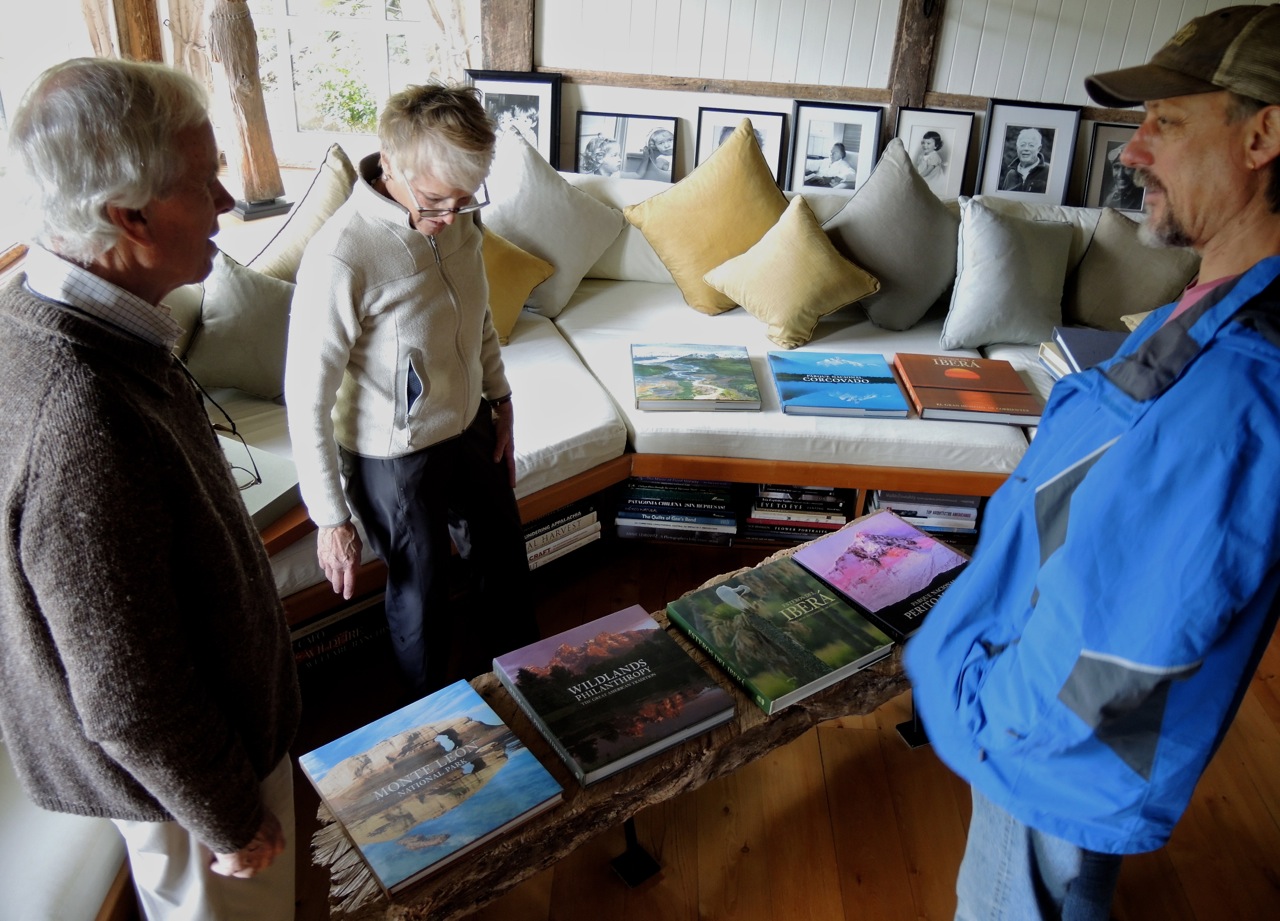
In Memory Of
Doug was the most remarkable and accomplished person many of us have ever met. His death is devastating for the thousands of people whom he knew as colleagues, employees and friends as well as to the wild Earth that he spent his life fighting for. While the movement will be less without him, we are sure that the communities closest to him will become more tightly woven with even greater resolve to carry on the legacy of his work.
After hearing of Doug’s death, Nancy wrote to us, saying in part: “In the coming days when this loss is so raw and painful, I’m going to try to bring Doug’s finest qualities to mind and incorporate them into everything I do – holding true to my vision, paying attention to detail, to quality, to beauty – just as Doug did in everything he undertook, as a way of honoring him.”
Doug’s death is an invitation to all of us, as Doug said, to “pay our dues to live on this Earth.” We loved him and loved the radical, simple, yet grand ideas he stood for.
We will miss you dearly, Doug.
by Dave Henson and Brock Dolman, with help from Kerry Brady
Rick Ridgeway (who was with Doug at the time of the accident) read this Maya Angelou poem at Doug’s memorial in Patagonia:
“When Great Trees Fall”

When great trees fall,
rocks on distant hills shudder,
lions hunker down
in tall grasses,
and even elephants
lumber after safety.
When great trees fall
in forests,
small things recoil into silence,
their senses
eroded beyond fear.
When great souls die,
the air around us becomes
light, rare, sterile.
We breathe, briefly.
Our eyes, briefly,
see with
a hurtful clarity.
Our memory, suddenly sharpened,
examines,
gnaws on kind words
unsaid,
promised walks
never taken.

Great souls die and
our reality, bound to
them, takes leave of us.
Our souls,
dependent upon their
nurture,
now shrink, wizened.
Our minds, formed
and informed by their
radiance, fall away.
We are not so much
maddened
as reduced to the unutterable ignorance of
dark, cold
caves.
And when great souls die,
after a period peace blooms,
slowly and always
irregularly. Spaces fill
with a kind of
soothing electric vibration.
Our senses, restored, never
to be the same, whisper to us.
They existed. They existed.
We can be. Be and be
better. For they existed.
― Maya Angelou
